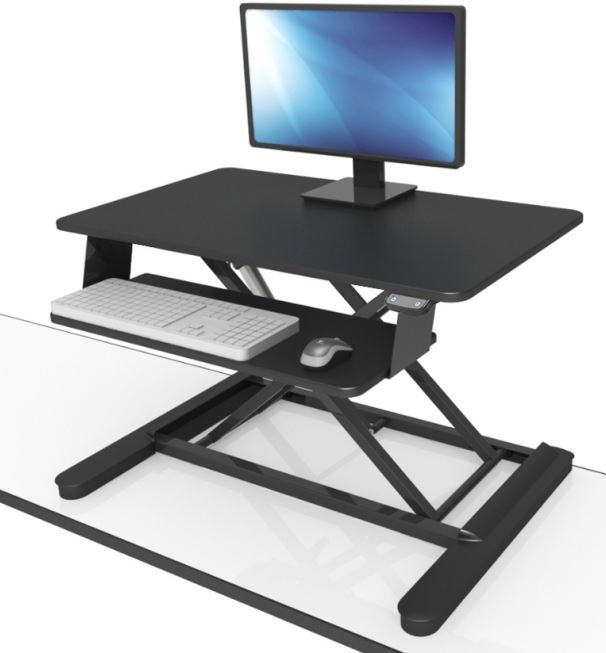Studies have shown that the best ergonomic solutions will improve productivity.
For example, ergonomic keyboards can help a typist to type faster with fewer breaks; and a monitor or monitor arm set to the correct height and distance will reduce eye strain resulting in less chance of headaches occurring.
Ergonomic equipment is mainstream now and definitely here to stay, however, it is not always as simple as purchasing the correct products for yourself and your team. In essence, ergonomic products should offer adjustability to suit the user’s needs. Hence, for an ergonomic product to do what it is designed to do, it works best when adapted to the individual users’ requirements.
Despite the availability and supply of adjustable office furniture and equipment, employees are not always aware of how to set themselves up correctly.

We provide below some guidelines that offer tips on best utilising your ergonomic equipment. We can break this down into two key areas.
Working when sitting and working when standing.
As sit stand electric workstations are becoming more apparent in the workplace, it is important to distinguish the differences in each setup.
See our Sitting Workstation Setup Guide
An ergonomic chair consisting of either a 3 Lever mechanism or Syncro mechanism is advised.
All the chairs in our range (see our range of Ergonomic Chairs here) provide one of these mechanisms. Ideally you want the seat depth to give you around a 2-3 finger distance between the back of knee and the seat. You should adjust the seat height as well so that your knees are around 90 degrees, and your feet are flat on the floor.

If your feet can’t reach the floor then a footrest is required.
The seat tilt and back tilt or back movement if you have the syncro mechanism, settings are less strict. Find the place that gives you the most comfort. Feel free to make small changes with the settings from day to day, as utilising different positions can be beneficial too.
Some occupational therapists will recommend sitting on a slight decline, while others say the opposite. Ultimately, it’s up to the user to find out what they find the most comfortable. The chair should have an adjustable back so you can get the lumbar in the correct position in the small of your back.
When you are working at your desk you want your elbows to be slightly above the desktop, between 90 and 100 degrees. This may mean that you need to bring your chair up higher. Remember if this means you now can’t touch the ground with your feet you will need a footrest.

You do not want to be too close to your monitor as you can suffer from eye strain and neck pain.
Ideally you want your eyes to be in line with the top of the screen, and you want the screen to be about arm’s length away. If your monitor is too low or in the wrong position you can benefit greatly by using a monitor arm or monitor platform.
Have a look at our monitor category for some products that would assist with this.
If you are referring to documents frequently, then you can easily develop neck pain and strain from the constant neck movements to the left and right, up and down. If you make use of an in-line document holder, you can bring the paperwork up closer to your eye level, and you will remain in a more neutral central position.
Here are some recommended document holders - https://www.ergonomicessentials.com.au/accessories/document-holders/

For your mouse and keyboard, there are many different options. A good starting point is a vertical mouse and a compact keyboard.
A vertical mouse puts your wrist in a more comfortable ‘handshake position’ to reduce strain. A compact keyboard does away with the numeric keypad, so that the mouse can be brought in closer to a central position to help reduce any shoulder pain caused from over-extending while using the mouse. With that in mind have a look at some of our options here. Compact Keyboards Vertical Mice
See our Standing Workstation Setup Guide
As we move to a standing position some of the elements above stay the same. The chair has now gone, however the keyboard/mouse/headset/document holder etc, remains the same. We want our elbows to stay slightly above the desktop, between 90 and 110 degrees. If your desk does not come up high enough to do this, then you may need a new electric desk or standing workstation.
Two popular options are the Vertilift Electric Desk and the Maxishift Electric Workstation. Both of these go high enough to suit just about everyone. 
When standing you may want to make slight adjustments to your monitor position, having a monitor arm as described above lets you do this easily.
Lastly when standing, an anti-fatigue mat is recommended as it can provide relief and reduce fatigue when standing for long periods.
Using a standing workstation can be tiring at first, as it is a big adjustment for many of us to make. By utilising an anti-fatigue mat, it makes this change a lot easier to do, and it can help motivate people to make the most of their standing workstation.

We hope that this brief overview has given you some clarity on what to consider when setting up an ergonomic workstation. If you have any questions or want to order any of the products mentioned above, give us a call on 1300 798 658 or contact us at sales@ergonomiceessentials.com.au